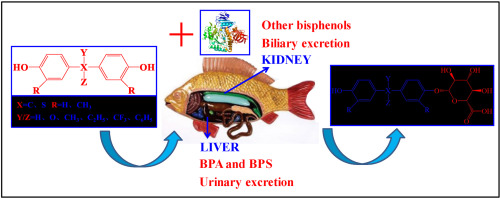当前位置:
X-MOL 学术
›
Ecotox. Environ. Saf.
›
论文详情
Our official English website, www.x-mol.net, welcomes your feedback! (Note: you will need to create a separate account there.)
Toxicokinetics and bioaccumulation characteristics of bisphenol analogues in common carp (Cyprinus carpio).
Ecotoxicology and Environmental Safety ( IF 6.8 ) Pub Date : 2020-01-15 , DOI: 10.1016/j.ecoenv.2020.110183 Qiang Wang 1 , Meng Chen 2 , Liwen Qiang 1 , Wei Wu 2 , Jing Yang 2 , Lingyan Zhu 3
Ecotoxicology and Environmental Safety ( IF 6.8 ) Pub Date : 2020-01-15 , DOI: 10.1016/j.ecoenv.2020.110183 Qiang Wang 1 , Meng Chen 2 , Liwen Qiang 1 , Wei Wu 2 , Jing Yang 2 , Lingyan Zhu 3
Affiliation

|
Toxicokinetics and bioconcentration of eight common bisphenol analogues, including bisphenol A (BPA), -B, -C, -E, -S, -Z, -AF, and -AP in common carp (Cyprinus carpio) were investigated. Both free (BPfree) and total forms (BPtotal) of the bisphenols were measured in various fish tissues. The conjugated forms of bisphenols were calculated based on BPfree and BPtotal. The calculated bioconcentration factors (BCFs) based on the total bisphenols (BPtotal) in the carp whole body were in the range of 0.3-320, agreeing with previous field results from Taihu Lake, China. The elimination rate constant (ke) positively correlated with the fraction of conjugated form (fconjugated), which displayed negative correlation with their log Kow (r = -0.861, p < 0.05), indicating that conjugation facilitated their elimination and those with higher hydrophobicity were more difficult to be eliminated. Except BPA, the concentrations of all bisphenols in the carp tissues were in the order of kidney > liver ≫ muscle. The uptake rate constants (ku) in kidney (r = 0.836, p < 0.05) and in liver (r = 0.863, p < 0.05) displayed significantly positive correlations with BCFs, and ku in kidney was greater than in liver except BPA. These results indicated that kidney and liver played important roles in accumulating bisphenols in carp, and kidney made more contribution than liver for most bisphenols. Biliary excretion predominated for elimination of most bisphenols while BPA and BPS were mainly through urinary excretion.
更新日期:2020-01-16


























 京公网安备 11010802027423号
京公网安备 11010802027423号